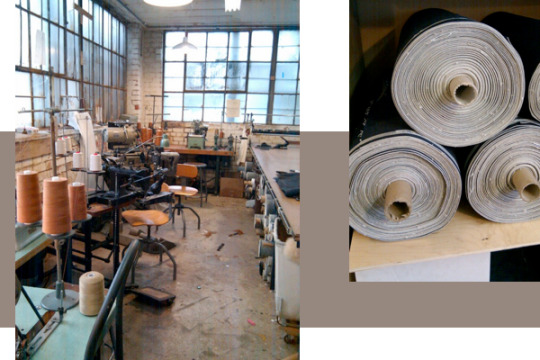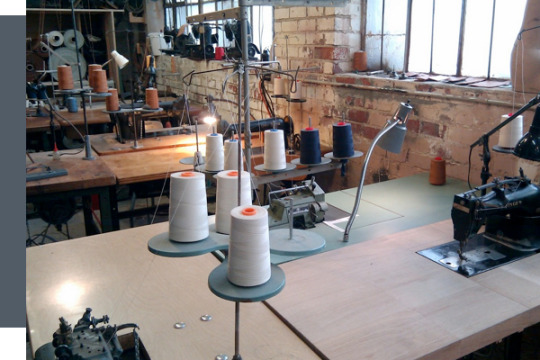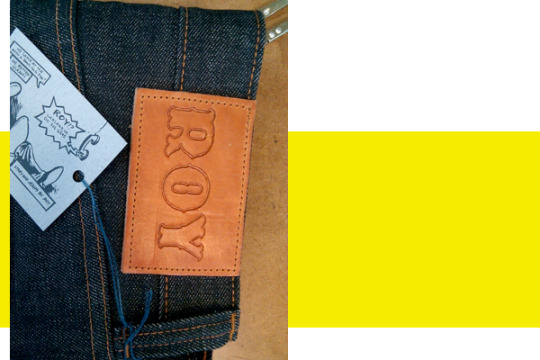Interview: Roy Slaper

Here’s one for all you serious denim-heads out there. Introducing Roy Slaper, the man behind every cut & stitch of Roy jeans. He was gracious enough to invite me into his Oakland studio for a tour of vintage machines and a better understanding of his past and process.
Tell us about the birth of Roy jeans.
I started 3 years ago in my studio apartment. The idea from the beginning was that I was going to make jeans. I bought my first machine from a man named Richard, who is now a friend, and told him that I needed a sewing machine with which to make jeans. He said, “Wait, wait, wait – why are you doing this?” What he wanted to know was whether I was motivated by money or if, as he put it, “Ok, good, you’re doing it for the love – because if you’re not, you wont make a penny.” The truth is that I didn’t know why I was doing it. I was just very driven toward making the jeans. You’re hungry and you eat.

What does your crafting carry from your past? And how do you think it will direct your future?
I would first like to address the word “crafting.” I have some strong opinions about craft in the sense of craftsmanship and skill. I don’t like the association that the word has now. In the past craft meant the culmination of years of practice and training expressed and visible in the finished piece. It was a noun. In the present, the term has become synonymous with glue gunning and poor quality DIY. Its a dead term to anyone doing quality, professional work. I think its even noted archaic in Oxford’s.
I have a diverse professional history. Currently, I am a metal fabricator and have been doing this for about 10 years. The transition from metal to cloth was not difficult. Both require spacial thought, pattern making and measurement of irregular objects. So many factors from past work have helped me, it would be a very long answer to point up each one.
The interplay of my metal life and denim life is making both advance in a way that they otherwise wouldn’t have. Its good, the future is good.

What do you find to be the most beautiful part of the process?
For me the actual jeans process is entwined with the fixing and care of my machines. To me, making clothing, designing, sewing and machine repair are all one subject. I really enjoy the machinery. Getting a total basket case machine and fixing it, is right up there on the beauty scale. Second, maybe, only to finding it in the first place. Digging through some basement and finding one of my precious little heaps, that’s the most beautiful thing in the world.
What would you consider quality denim, and quality jeans?
I’ve heard that you can give an old, senile person a piece of nice cloth for them to feel and it will keep them occupied pleasantly for quite a long time. If this is true, then I might be worse off than I thought. There is a complexity to quality denim that is apparent in the touch. I like to feel it and now that I’m familiar, I get the feeling in my hand when I see it. So, for me, quality denim feels good to look at.
Quality jeans last many years and get better with age. Once again, familiarity with that which lasts, helps me see quality when it is new.

How important is “the machine” in crafting a quality pair of jeans?
Different machines have different characteristics. I like the character of stitch that many older machines have. Contrary to what might be expected, it is because I find the older machines to be more perfect in the actual stitch formation. I was told early on, by Billy at Apparel City, that I should get old machines because the steel was better back then. He was right. Analogies abound. “Dude, its like playing an American Fender Strat while driving a ’58 Benz while listening to a wide groove mono Kind of Blue on a Thorins turntable through a tube amp and reading the December ’68 Playboy…”
If you could only take one machine with you to a desert island, which one would it be?
I think if I was going to a desert island, I would bring a treadle-power single needle lockstitch since there probably wouldn’t be any electricity. That would be handy, those castaways always get to looking so ratty.